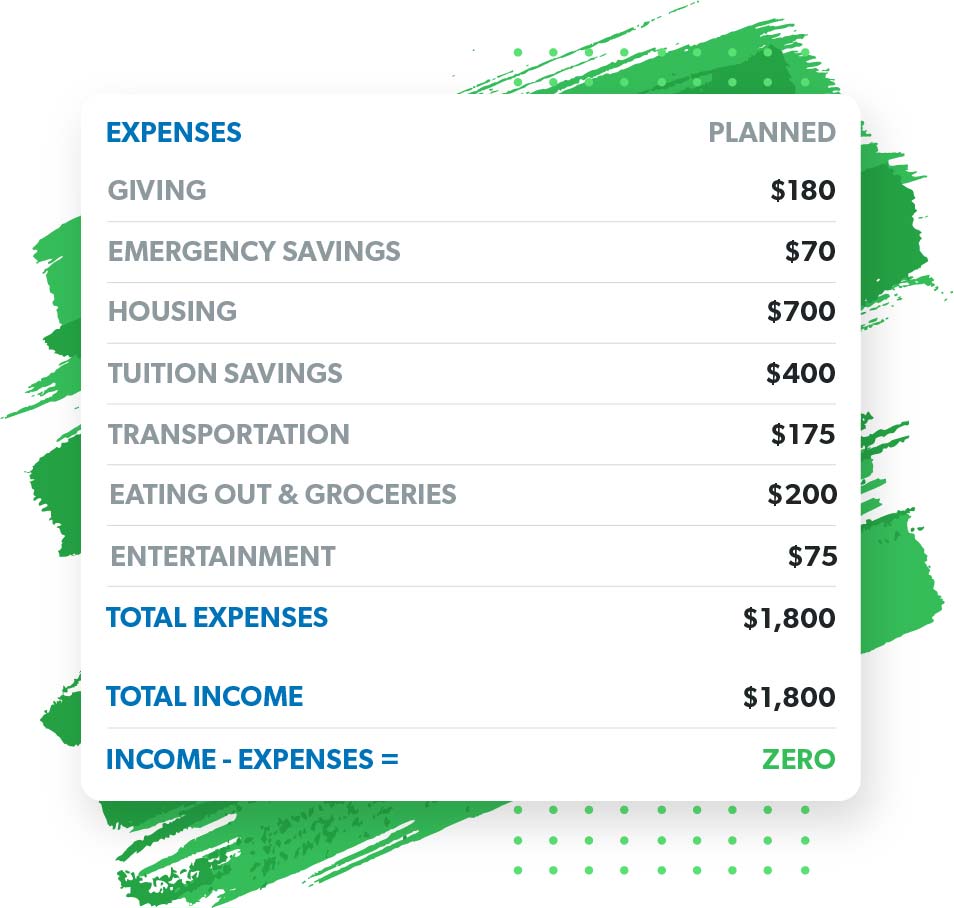Key Takeaways
- A budget (specifically a zero-based budget) is essential to success in college—helping you take control of your money and avoid stressing about finances (because college is stressful enough).
- Creating a budget is easy: List all of your income, write down every expense, subtract your expenses from your income to reach zero, and track your spending throughout the month.
- There are lots of ways to free up cash and create margin in your budget, like buying used textbooks, taking advantage of scholarships, eating at home, becoming an RA at your dorm, and more.
- You should start budgeting now, not later, to get the most out of your money during your college career.
If you’re in college, that means you’ve got a lot on your plate. Keeping up good grades. Hanging out with your friends. Studying for exams. Picking the perfect T-shirt and sweatpants combo every morning.
Get expert money advice to reach your money goals faster!
Yeah, all that stuff is important. But there’s something else you need to keep in mind—I’m talking about making good financial decisions.
Take it from someone who had to pay off six figures of student debt (yep, you read that right). Studying hard and managing your money are both equally important to your future. And staying on top of your money as a student starts with a good college budget.
Like I wrote in my book Money’s Not a Math Problem, budgets are like toothbrushes—everyone needs one, and things get nasty real quick without one. So, let’s walk through the steps you need to make a solid budget while you’re in school.
How to Make a College Budget
1. Write down your income.
A budget is just a customized plan for your money where you decide—before each month begins—how much you’re going to give, save and spend. So the first step to making a budget is figuring out how much money you have to start with.
Add up the money you’ll have coming in during the upcoming month from all sources—including what you’ll make from your day job, side hustles, any scholarships that are paid to you directly, and any cash you’ll get from your parents. (Make sure you thank your folks if they give your bank account a lift.)
If your income changes month to month and you don’t know exact numbers yet, that’s no problem—just make your best guess. Once you’ve got all the numbers, write them down on your budget. Here’s what that could look like:

2. List your expenses.
Next, you’ll want to write down everything you spend money on. And I mean everything! To get you started, here are some common monthly expenses that apply to most college students:
- Food: Whether you have a campus meal plan or you buy your own groceries, you’ll have to pay for your food.
- Textbooks: College book prices are out of pocket. And by that, I mean they’re expensive! But you can save money on textbooks if you know where to look.
- Transportation: Whether you drive a car, ride a bike, or take the bus, you’ll be paying for transportation. This can include the basics like gas, oil changes and car insurance, as well as extras like parking passes.
- Housing: Unless you live at home, you’ll either pay for a dorm or an apartment. Or you can do what I did and pay $150 a month to sleep on your friend’s futon. Either way, it’s going to cost you, so you need to budget for it.
- Entertainment: You’ve got to have a little bit of fun in college, right? These costs can cover everything from movie tickets to paddles for intramural pickleball. (Hey, you do you.)
- Giving: Generosity doesn’t require a degree! I recommend giving 10% of your income each month—either to your local church or a charity.
- Savings: Make sure you have money left over each month to put aside for emergencies or future tuition payments.
Now, that list is a great starting point, but you may have some other expenses that aren’t on it. So, look back at your recent bank statements or receipts and think about everything you spend money on. You don’t want anything to sneak up on you down the road—even your weekly stop at the donut shop.
Once you’ve organized your budget categories, plan how much you’ll spend for each one. Personally, I put giving and saving at the top of my list to keep my priorities in check. Then I move on to the other categories.
Some expenses that cost the same each month, like Netflix and rent, are easy to plan for. Others, like food and transportation, are more unpredictable. To make those easier, look at what you spent last month in each category and use that as a guide.
Find Margin You Didn’t Know You Had With EveryDollar
The EveryDollar budgeting app helps you find extra money every month so you can beat debt, build wealth, and make progress. Every. Day.
3. Subtract your expenses from your income.
Once you’ve assigned a dollar amount to every category, it’s time to whip out your calculator. If you’re anything like me, you’re ready to dip once math is mentioned. But hang on—I promise this isn’t complicated at all.
All you need to do is add up the expenses you just listed, including what you plan to give, save and spend. Then, subtract that total from your income.
You want that number to be a big fat zero. Why? Because a zero-based budget, where your income minus your expenses equals zero, is the only type of budget that works in the long haul. It means giving every single dollar a job.
So, if your total expenses are less than your income, give that leftover money something to do—maybe you add it to savings or give it to a cause you care about. And if your total expenses are more than your income, you have two great options: increasing your income (trust me, there are plenty of ways to make extra money in college) or cutting back on your expenses (we’ll go over some tips on how to do that a little bit later).
Here’s what your budget might look like with the example income we used in the first step.

4. Track your spending.
Once you get to this point, you’ve officially made your first college student budget. Let’s go! Give yourself a minute to celebrate this win.
But you’re not quite done with the entire process. Turns out, you can’t just make a budget and expect something to happen—you have to stick to it.
The biggest key to sticking to your budget is tracking your spending throughout the month. If you wait until the end of the month to see if you’re on track, you’re too late!
How to Cut Back on College Expenses
If you need to free up some room in your budget, cutting back on spending is an easy way to make that happen. Here are some of my favorite tips for saving money in college and how you can lower your monthly expenses.
How to Save Money on Tuition
There’s a tried and true way to cut back on tuition costs that every student should take advantage of: scholarships. But I’m already in college. Isn’t it too late for me to get scholarships? No! Plenty of scholarships are available, especially for students already enrolled in college. So start looking for ones you’d qualify for and apply to as many as you can.
How to Save Money on Food
A lot of colleges require meal plans if you live on campus. If that’s you, try getting as much bang for your buck as possible. Eating in the cafeteria isn’t as fun as running to Taco Bell or Chick-fil-A, but try to avoid eating at restaurants as much as possible.
I know some cafeteria food has the nutritional value of Play-Doh, but you can find good options. And you’re already paying for it, so you might as well get your money’s worth.
If you don’t have a meal plan, try buying groceries and eating at home more often than eating out. That’ll save you a ton of money in the long run.
How to Save Money on Textbooks
Shopping at your school’s bookstore may be the easiest and most convenient way to buy books, but it’s not the cheapest. You can get used books for a lot less on sites like Chegg, eBay or Amazon. (Just make sure you purchase the right version.) You can also save some money by renting books instead of buying them.
How to Save Money on Entertainment
Your college probably offers a lot of free entertainment—like clubs, intramural sports, concerts and more. Ask older students for some ways to have fun on campus without reaching into your wallet. (Just make sure your “entertainment” doesn’t involve something that would get the police called . . .)
You can also cut back on your entertainment budget by cutting down on the music and TV streaming services you pay for. Do you really need Netflix, Hulu, HBO Max and Disney+? Nope, and you can also choose from tons of free streaming services.
How to Save Money on Housing
Deciding on the best plan for college housing can be tricky. Sometimes, on-campus housing is the most affordable option. Other times, finding a roommate and renting an apartment off campus is your best bet. Do your research and figure out which choice is the most affordable—and make sure your “bargain” apartment isn’t full of bedbugs and broken dreams. No thank you.
By the way, if you do live on campus, becoming a resident assistant (aka an RA) is a great way to save money on housing. RAs monitor the dorms and help with student activities, and in exchange, they typically get discounted housing and a cash stipend on top of that.
Start Budgeting Today!
Here’s the cold, hard truth: If you don’t have a budget, you’re not in control of your money. A budget is a game plan, and you lose the game when you don’t have one. I don’t want that for you—I want you to win.
And don’t wait to get started! Oh, I’ll make a budget right after I finish that sociology paper and eat my grilled cheese. Child, please. You and I both know that’s not going to happen. Do it now!
Next Steps
1. Add up all your sources of income.
2. Figure out your typical monthly expenses.
3. Download the EveryDollar app to create your first budget.




